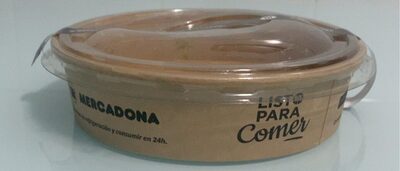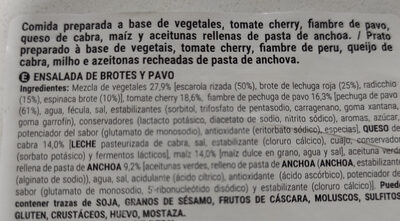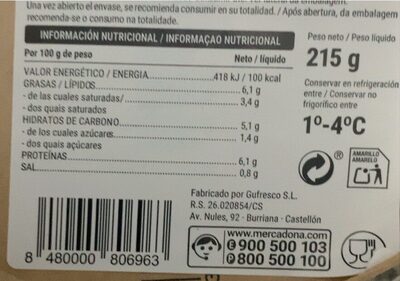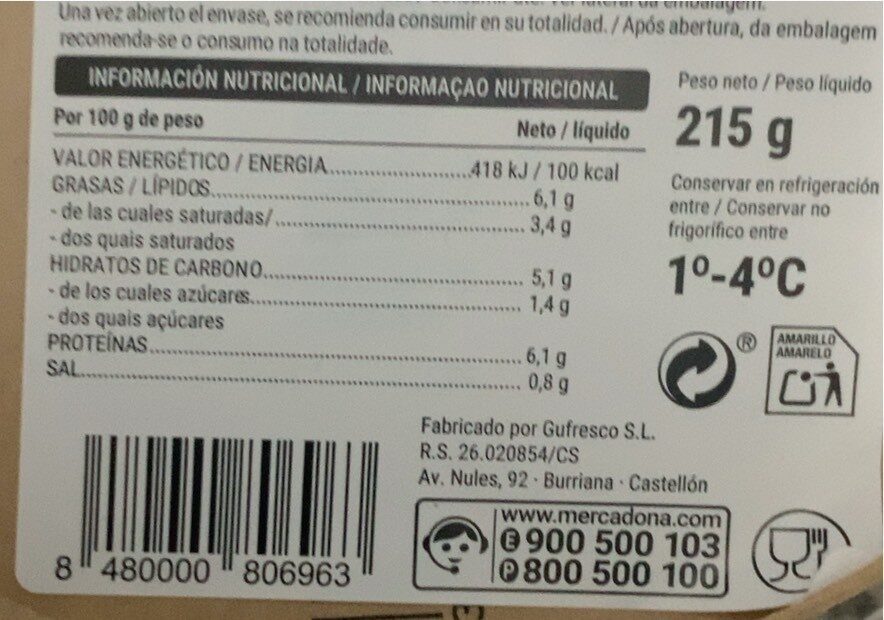Help us make food transparency the norm!
As a non-profit organization, we depend on your donations to continue informing consumers around the world about what they eat.
The food revolution starts with you!
Ensalada de brotes y pavo - Endalada - 215
Ensalada de brotes y pavo - Endalada - 215
This product page is not complete. You can help to complete it by editing it and adding more data from the photos we have, or by taking more photos using the app for Android or iPhone/iPad. Thank you!
×
Barcode: 8480000806963 (EAN / EAN-13)
Quantity: 215
Packaging: Container
Brands: Endalada
Categories: Meals, Prepared salads, Salads
Labels, certifications, awards:
Green Dot
Countries where sold: United States
Matching with your preferences
Health
Ingredients
-
58 ingredients
: Mezcla de vegetales 27,9% [escarola rizada (50%), brote de lechuga roja (25%), radicchio (15%), espinaca brote (10%)], tomate cherry 18,6%, fiambre de pechuga de pavo 16,3% [pechuga de pavo (61%), agua, fécula, sal, estabilizantes (sorbitol, trifosfato de pentasodio, carragenano, goma xantana, goma garrofin), conservadores (lactacto potásico, diacetato de sodio, nitrito sódico), aromas, azúcar, potenciador del sabor (glutamato de monosodio), antioxidante (eritorbato sódico), especias], QUESO de cabra 14,0% (LECHE pasteurizada de cabra, sal, estabilizante (cloruro cálcico), cuajo, conservadon (sorbato potásico) y fermentos lácticos), maiz 14,0% [maiz dulce en grano, agua y sal], aceituna verda rellena de pasta de ANCHOA 9,2 % [aceitunas verdes, relleno de pasta de ANCHOA (ANCHOA, estabilizante (alginato de sodio)), agua, sal, acidulante (ácido citrico), antioxidante (ácido ascórbico), potenciador de sabor (glutamato de monosodio, 5-ribonucleótido disódico) y estabilizante (cloruro cálcico)]. Pued contener trazas de SOJA, GRANOS DE SÉSAMO, FRUTOS DE CÁSCARA, MOLUSCOS, SULFITOS GLUTEN, CRUSTÁCEOS, HUEVO, MOSTAZA.Allergens: MilkTraces: Crustaceans, Eggs, Molluscs, Mustard, Nuts, Sesame seeds, Soybeans
Food processing
-
Ultra processed foods
Elements that indicate the product is in the 4 - Ultra processed food and drink products group:
- Additive: E401 - Sodium alginate
- Additive: E407 - Carrageenan
- Additive: E410 - Locust bean gum
- Additive: E415 - Xanthan gum
- Additive: E420 - Sorbitol
- Additive: E451 - Triphosphates
- Additive: E621 - Monosodium glutamate
- Additive: E635 - Disodium 5'-ribonucleotide
- Ingredient: Flavour enhancer
- Ingredient: Flavouring
Food products are classified into 4 groups according to their degree of processing:
- Unprocessed or minimally processed foods
- Processed culinary ingredients
- Processed foods
- Ultra processed foods
The determination of the group is based on the category of the product and on the ingredients it contains.
Additives
-
E202 - Potassium sorbate
Potassium sorbate (E202) is a synthetic food preservative commonly used to extend the shelf life of various food products.
It works by inhibiting the growth of molds, yeast, and some bacteria, preventing spoilage. When added to foods, it helps maintain their freshness and quality.
Some studies have shown that when combined with nitrites, potassium sorbate have genotoxic activity in vitro. However, potassium sorbate is generally recognized as safe (GRAS) by regulatory authorities.
-
E250 - Sodium nitrite
Sodium nitrite: Sodium nitrite is the inorganic compound with the chemical formula NaNO2. It is a white to slightly yellowish crystalline powder that is very soluble in water and is hygroscopic. It is a useful precursor to a variety of organic compounds, such as pharmaceuticals, dyes, and pesticides, but it is probably best known as a food additive to prevent botulism. It is on the World Health Organization's List of Essential Medicines, the most important medications needed in a basic health system.Nitrate or nitrite -ingested- under conditions that result in endogenous nitrosation has been classified as "probably carcinogenic to humans" by International Agency for Research on Cancer -IARC-.Source: Wikipedia
-
E262 - Sodium acetates
Sodium acetate: Sodium acetate, CH3COONa, also abbreviated NaOAc, is the sodium salt of acetic acid. This colorless deliquescent salt has a wide range of uses.Source: Wikipedia
-
E262ii - Sodium diacetate
Sodium acetate: Sodium acetate, CH3COONa, also abbreviated NaOAc, is the sodium salt of acetic acid. This colorless deliquescent salt has a wide range of uses.Source: Wikipedia
-
E316 - Sodium erythorbate
Sodium erythorbate: Sodium erythorbate -C6H7NaO6- is a food additive used predominantly in meats, poultry, and soft drinks. Chemically, it is the sodium salt of erythorbic acid. When used in processed meat such as hot dogs and beef sticks, it increases the rate at which nitrite reduces to nitric oxide, thus facilitating a faster cure and retaining the pink coloring. As an antioxidant structurally related to vitamin C, it helps improve flavor stability and prevents the formation of carcinogenic nitrosamines. When used as a food additive, its E number is E316. The use of erythorbic acid and sodium erythorbate as a food preservative has increased greatly since the U.S. Food and Drug Administration banned the use of sulfites as preservatives in foods intended to be eaten fresh -such as ingredients for fresh salads- and as food processors have responded to the fact that some people are allergic to sulfites. It can also be found in bologna, and is occasionally used in beverages, baked goods, and potato salad.Sodium erythorbate is produced from sugars derived from different sources, such as beets, sugar cane, and corn. An urban myth claims that sodium erythorbate is made from ground earthworms; however, there is no truth to the myth. It is thought that the genesis of the legend comes from the similarity of the chemical name to the words earthworm and bait.Alternative applications include the development of additives that could be utilized as anti-oxidants in general. For instance, this substance has been implemented in the development of corrosion inhibitors for metals and it has been implemented in active packaging.Sodium erythorbate is soluble in water. The pH of the aqueous solution of the sodium salt is between 5 and 6. A 10% solution, made from commercial grade sodium erythorbate, may have a pH of 7.2 to 7.9. In its dry, crystalline state it is nonreactive. But, when in solution with water it readily reacts with atmospheric oxygen and other oxidizing agents, which makes it a valuable antioxidant.Source: Wikipedia
-
E330 - Citric acid
Citric acid is a natural organic acid found in citrus fruits such as lemons, oranges, and limes.
It is widely used in the food industry as a flavor enhancer, acidulant, and preservative due to its tart and refreshing taste.
Citric acid is safe for consumption when used in moderation and is considered a generally recognized as safe (GRAS) food additive by regulatory agencies worldwide.
-
E407 - Carrageenan
Carrageenan (E407), derived from red seaweed, is widely employed in the food industry as a gelling, thickening, and stabilizing agent, notably in dairy and meat products.
It can exist in various forms, each imparting distinct textural properties to food.
However, its degraded form, often referred to as poligeenan, has raised health concerns due to its potential inflammatory effects and its classification as a possible human carcinogen (Group 2B) by the International Agency for Research on Cancer (IARC).
Nevertheless, food-grade carrageenan has been deemed safe by various regulatory bodies when consumed in amounts typically found in food.
-
E410 - Locust bean gum
Locust bean gum: Locust bean gum -LBG, also known as carob gum, carob bean gum, carobin, E410- is a thickening agent and a gelling agent used in food technology.Source: Wikipedia
-
E415 - Xanthan gum
Xanthan gum (E415) is a natural polysaccharide derived from fermented sugars, often used in the food industry as a thickening and stabilizing agent.
This versatile food additive enhances texture and prevents ingredient separation in a wide range of products, including salad dressings, sauces, and gluten-free baked goods.
It is considered safe for consumption even at high intake amounts.
-
E420 - Sorbitol
Sorbitol: Sorbitol --, less commonly known as glucitol --, is a sugar alcohol with a sweet taste which the human body metabolizes slowly. It can be obtained by reduction of glucose, which changes the aldehyde group to a hydroxyl group. Most sorbitol is made from corn syrup, but it is also found in nature, for example in apples, pears, peaches, and prunes. It is converted to fructose by sorbitol-6-phosphate 2-dehydrogenase. Sorbitol is an isomer of mannitol, another sugar alcohol; the two differ only in the orientation of the hydroxyl group on carbon 2. While similar, the two sugar alcohols have very different sources in nature, melting points, and uses.Source: Wikipedia
-
E451 - Triphosphates
Sodium triphosphate: Sodium triphosphate -STP-, also sodium tripolyphosphate -STPP-, or tripolyphosphate -TPP-,- is an inorganic compound with formula Na5P3O10. It is the sodium salt of the polyphosphate penta-anion, which is the conjugate base of triphosphoric acid. It is produced on a large scale as a component of many domestic and industrial products, especially detergents. Environmental problems associated with eutrophication are attributed to its widespread use.Source: Wikipedia
-
E451i - Pentasodium triphosphate
Sodium triphosphate: Sodium triphosphate -STP-, also sodium tripolyphosphate -STPP-, or tripolyphosphate -TPP-,- is an inorganic compound with formula Na5P3O10. It is the sodium salt of the polyphosphate penta-anion, which is the conjugate base of triphosphoric acid. It is produced on a large scale as a component of many domestic and industrial products, especially detergents. Environmental problems associated with eutrophication are attributed to its widespread use.Source: Wikipedia
-
E621 - Monosodium glutamate
Monosodium glutamate: Monosodium glutamate -MSG, also known as sodium glutamate- is the sodium salt of glutamic acid, one of the most abundant naturally occurring non-essential amino acids. Glutamic acid is found naturally in tomatoes, grapes, cheese, mushrooms and other foods.MSG is used in the food industry as a flavor enhancer with an umami taste that intensifies the meaty, savory flavor of food, as naturally occurring glutamate does in foods such as stews and meat soups. It was first prepared in 1908 by Japanese biochemist Kikunae Ikeda, who was trying to isolate and duplicate the savory taste of kombu, an edible seaweed used as a base for many Japanese soups. MSG as a flavor enhancer balances, blends, and rounds the perception of other tastes.The U.S. Food and Drug Administration has given MSG its generally recognized as safe -GRAS- designation. A popular belief is that large doses of MSG can cause headaches and other feelings of discomfort, known as "Chinese restaurant syndrome," but double-blind tests fail to find evidence of such a reaction. The European Union classifies it as a food additive permitted in certain foods and subject to quantitative limits. MSG has the HS code 29224220 and the E number E621.Source: Wikipedia
Ingredients analysis
-
Palm oil content unknown
Unrecognized ingredients: es:brote-de-lechuga-roja, es:espinaca-brote, es:fiambre-de-pechuga-de-pavo, es:lactacto-potasico, es:conservadon, es:maiz-dulce-en-grano, es:aceituna-verda-rellena-de-pasta-de-anchoa, es:relleno-de-pasta-de-anchoaSome ingredients could not be recognized.
We need your help!
You can help us recognize more ingredients and better analyze the list of ingredients for this product and others:
- Edit this product page to correct spelling mistakes in the ingredients list, and/or to remove ingredients in other languages and sentences that are not related to the ingredients.
- Add new entries, synonyms or translations to our multilingual lists of ingredients, ingredient processing methods, and labels.
If you would like to help, join the #ingredients channel on our Slack discussion space and/or learn about ingredients analysis on our wiki. Thank you!
-
Non-vegan
Non-vegan ingredients: Turkey breast, Goat cheese, Pasteurised goat milk, AnchovySome ingredients could not be recognized.
We need your help!
You can help us recognize more ingredients and better analyze the list of ingredients for this product and others:
- Edit this product page to correct spelling mistakes in the ingredients list, and/or to remove ingredients in other languages and sentences that are not related to the ingredients.
- Add new entries, synonyms or translations to our multilingual lists of ingredients, ingredient processing methods, and labels.
If you would like to help, join the #ingredients channel on our Slack discussion space and/or learn about ingredients analysis on our wiki. Thank you!
-
Non-vegetarian
Non-vegetarian ingredients: Turkey breast, AnchovySome ingredients could not be recognized.
We need your help!
You can help us recognize more ingredients and better analyze the list of ingredients for this product and others:
- Edit this product page to correct spelling mistakes in the ingredients list, and/or to remove ingredients in other languages and sentences that are not related to the ingredients.
- Add new entries, synonyms or translations to our multilingual lists of ingredients, ingredient processing methods, and labels.
If you would like to help, join the #ingredients channel on our Slack discussion space and/or learn about ingredients analysis on our wiki. Thank you!
-
Details of the analysis of the ingredients
We need your help!
Some ingredients could not be recognized.
We need your help!
You can help us recognize more ingredients and better analyze the list of ingredients for this product and others:
- Edit this product page to correct spelling mistakes in the ingredients list, and/or to remove ingredients in other languages and sentences that are not related to the ingredients.
- Add new entries, synonyms or translations to our multilingual lists of ingredients, ingredient processing methods, and labels.
If you would like to help, join the #ingredients channel on our Slack discussion space and/or learn about ingredients analysis on our wiki. Thank you!
: Mezcla de vegetales 27.9% (escarola rizada 50%, brote de lechuga roja 25%, radicchio 15%, espinaca brote 10%), tomate cherry 18.6%, fiambre de pechuga de pavo 16.3% (pechuga de pavo 61%, agua, fécula, sal, estabilizantes (sorbitol, trifosfato de pentasodio, carragenano, goma xantana, goma garrofin), conservadores (lactacto potásico, diacetato de sodio, nitrito sódico), aromas, azúcar, potenciador del sabor (glutamato de monosodio), antioxidante (eritorbato sódico), especias), QUESO de cabra 14% (LECHE pasteurizada de cabra, sal, estabilizante (cloruro cálcico), cuajo, conservadon (sorbato potásico), fermentos lácticos), maiz 14% (maiz dulce en grano, agua, sal), aceituna verda rellena de pasta de ANCHOA 9.2% (aceitunas verdes, relleno de pasta de ANCHOA (ANCHOA, estabilizante (alginato de sodio)), agua, sal, acidulante (ácido citrico), antioxidante (ácido ascórbico), potenciador de sabor (glutamato de monosodio, 5-ribonucleótido disódico), estabilizante (cloruro cálcico))- Mezcla de vegetales -> en:vegetable-blend - vegan: yes - vegetarian: yes - percent: 27.9
- escarola rizada -> en:curly-endive - vegan: yes - vegetarian: yes - ciqual_food_code: 20012 - percent: 50
- brote de lechuga roja -> es:brote-de-lechuga-roja - percent: 25
- radicchio -> en:radicchio - vegan: yes - vegetarian: yes - percent: 15
- espinaca brote -> es:espinaca-brote - percent: 10
- tomate cherry -> en:cherry-tomato - vegan: yes - vegetarian: yes - ciqual_food_code: 20172 - percent: 18.6
- fiambre de pechuga de pavo -> es:fiambre-de-pechuga-de-pavo - percent: 16.3
- pechuga de pavo -> en:turkey-breast - vegan: no - vegetarian: no - ciqual_food_code: 36301 - percent: 61
- agua -> en:water - vegan: yes - vegetarian: yes - ciqual_food_code: 18066
- fécula -> en:starch - vegan: yes - vegetarian: yes - ciqual_proxy_food_code: 9510
- sal -> en:salt - vegan: yes - vegetarian: yes - ciqual_food_code: 11058
- estabilizantes -> en:stabiliser
- sorbitol -> en:e420 - vegan: yes - vegetarian: yes
- trifosfato de pentasodio -> en:e451i - vegan: yes - vegetarian: yes
- carragenano -> en:e407 - vegan: yes - vegetarian: yes
- goma xantana -> en:e415 - vegan: yes - vegetarian: yes
- goma garrofin -> en:e410 - vegan: yes - vegetarian: yes
- conservadores -> en:preservative
- lactacto potásico -> es:lactacto-potasico
- diacetato de sodio -> en:e262ii - vegan: yes - vegetarian: yes
- nitrito sódico -> en:e250 - vegan: yes - vegetarian: yes
- aromas -> en:flavouring - vegan: maybe - vegetarian: maybe
- azúcar -> en:sugar - vegan: yes - vegetarian: yes - ciqual_proxy_food_code: 31016
- potenciador del sabor -> en:flavour-enhancer
- glutamato de monosodio -> en:e621 - vegan: yes - vegetarian: yes
- antioxidante -> en:antioxidant
- eritorbato sódico -> en:e316 - vegan: yes - vegetarian: yes
- especias -> en:spice - vegan: yes - vegetarian: yes
- QUESO de cabra -> en:goat-cheese - vegan: no - vegetarian: maybe - ciqual_proxy_food_code: 12999 - percent: 14
- LECHE pasteurizada de cabra -> en:pasteurised-goat-milk - vegan: no - vegetarian: yes - ciqual_proxy_food_code: 19051
- sal -> en:salt - vegan: yes - vegetarian: yes - ciqual_food_code: 11058
- estabilizante -> en:stabiliser
- cloruro cálcico -> en:e509 - vegan: yes - vegetarian: yes
- cuajo -> en:rennet - vegan: maybe - vegetarian: maybe
- conservadon -> es:conservadon
- sorbato potásico -> en:e202 - vegan: yes - vegetarian: yes
- fermentos lácticos -> en:lactic-ferments - vegan: maybe - vegetarian: yes
- maiz -> en:corn - vegan: yes - vegetarian: yes - ciqual_food_code: 9200 - percent: 14
- maiz dulce en grano -> es:maiz-dulce-en-grano
- agua -> en:water - vegan: yes - vegetarian: yes - ciqual_food_code: 18066
- sal -> en:salt - vegan: yes - vegetarian: yes - ciqual_food_code: 11058
- aceituna verda rellena de pasta de ANCHOA -> es:aceituna-verda-rellena-de-pasta-de-anchoa - percent: 9.2
- aceitunas verdes -> en:green-olive - vegan: yes - vegetarian: yes - ciqual_food_code: 13033
- relleno de pasta de ANCHOA -> es:relleno-de-pasta-de-anchoa
- ANCHOA -> en:anchovy - vegan: no - vegetarian: no - ciqual_food_code: 26079
- estabilizante -> en:stabiliser
- alginato de sodio -> en:e401 - vegan: yes - vegetarian: yes
- agua -> en:water - vegan: yes - vegetarian: yes - ciqual_food_code: 18066
- sal -> en:salt - vegan: yes - vegetarian: yes - ciqual_food_code: 11058
- acidulante -> en:acid
- ácido citrico -> en:e330 - vegan: yes - vegetarian: yes
- antioxidante -> en:antioxidant
- ácido ascórbico -> en:e300 - vegan: yes - vegetarian: yes
- potenciador de sabor -> en:flavour-enhancer
- glutamato de monosodio -> en:e621 - vegan: yes - vegetarian: yes
- 5-ribonucleótido disódico -> en:e635 - vegan: maybe - vegetarian: maybe
- estabilizante -> en:stabiliser
- cloruro cálcico -> en:e509 - vegan: yes - vegetarian: yes
Nutrition
-
Average nutritional quality
⚠ ️Warning: the amount of fiber is not specified, their possible positive contribution to the grade could not be taken into account.⚠ ️Warning: the amount of fruits, vegetables and nuts is not specified on the label, it was estimated from the list of ingredients: 51This product is not considered a beverage for the calculation of the Nutri-Score.
Positive points: 4
- Proteins: 3 / 5 (value: 6.1, rounded value: 6.1)
- Fiber: 0 / 5 (value: 0, rounded value: 0)
- Fruits, vegetables, nuts, and colza/walnut/olive oils: 1 / 5 (value: 51.1, rounded value: 51.1)
Negative points: 7
- Energy: 1 / 10 (value: 418, rounded value: 418)
- Sugars: 0 / 10 (value: 1.4, rounded value: 1.4)
- Saturated fat: 3 / 10 (value: 3.4, rounded value: 3.4)
- Sodium: 3 / 10 (value: 320, rounded value: 320)
The points for proteins are counted because the negative points are less than 11.
Nutritional score: (7 - 4)
Nutri-Score:
-
Nutrient levels
-
Fat in moderate quantity (6.1%)
What you need to know- A high consumption of fat, especially saturated fats, can raise cholesterol, which increases the risk of heart diseases.
Recommendation: Limit the consumption of fat and saturated fat- Choose products with lower fat and saturated fat content.
-
Saturated fat in moderate quantity (3.4%)
What you need to know- A high consumption of fat, especially saturated fats, can raise cholesterol, which increases the risk of heart diseases.
Recommendation: Limit the consumption of fat and saturated fat- Choose products with lower fat and saturated fat content.
-
Sugars in low quantity (1.4%)
What you need to know- A high consumption of sugar can cause weight gain and tooth decay. It also augments the risk of type 2 diabetes and cardio-vascular diseases.
Recommendation: Limit the consumption of sugar and sugary drinks- Sugary drinks (such as sodas, fruit beverages, and fruit juices and nectars) should be limited as much as possible (no more than 1 glass a day).
- Choose products with lower sugar content and reduce the consumption of products with added sugars.
-
Salt in moderate quantity (0.8%)
What you need to know- A high consumption of salt (or sodium) can cause raised blood pressure, which can increase the risk of heart disease and stroke.
- Many people who have high blood pressure do not know it, as there are often no symptoms.
- Most people consume too much salt (on average 9 to 12 grams per day), around twice the recommended maximum level of intake.
Recommendation: Limit the consumption of salt and salted food- Reduce the quantity of salt used when cooking, and don't salt again at the table.
- Limit the consumption of salty snacks and choose products with lower salt content.
-
-
Nutrition facts
Nutrition facts As sold
for 100 g / 100 mlCompared to: Salads Energy 418 kj
(100 kcal)-32% Fat 6.1 g -29% Saturated fat 3.4 g +154% Carbohydrates 5.1 g -50% Sugars 1.4 g -52% Fiber ? Proteins 6.1 g +31% Salt 0.8 g -5% Fruits‚ vegetables‚ nuts and rapeseed‚ walnut and olive oils (estimate from ingredients list analysis) 51.1 %
Environment
-
Eco-Score not computed - Unknown environmental impact
We could not compute the Eco-Score of this product as it is missing some data, could you help complete it?Could you add a precise product category so that we can compute the Eco-Score? Add a category
Packaging
-
Packaging with a medium impact
-
Packaging parts
Container
-
Packaging materials
Material % Packaging weight
-
Transportation
-
Origins of ingredients
Missing origins of ingredients information
⚠ ️ The origins of the ingredients of this product are not indicated.
If they are indicated on the packaging, you can modify the product sheet and add them.
If you are the manufacturer of this product, you can send us the information with our free platform for producers.Add the origins of ingredients for this product Add the origins of ingredients for this product
Report a problem
-
Incomplete or incorrect information?
Category, labels, ingredients, allergens, nutritional information, photos etc.
If the information does not match the information on the packaging, please complete or correct it. Open Food Facts is a collaborative database, and every contribution is useful for all.
Data sources
Product added on by rosamary
Last edit of product page on by wolfgang8741.
Product page also edited by foodvisor, kiliweb, openfoodfacts-contributors, packbot, yuka.sY2b0xO6T85zoF3NwEKvlhRqWYCPmivIO0X5nhzQ6uicBKzkP81j4dD7Yqs.










